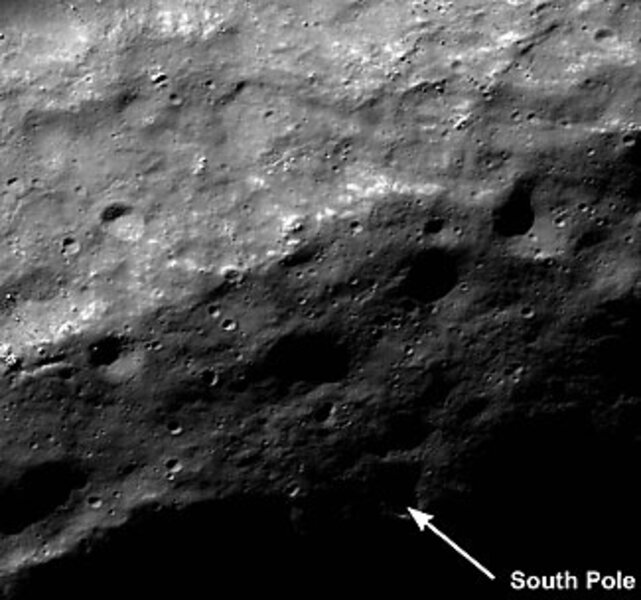Coldest place in the solar system? Look to the moon.
Loading...
Looking for the ultimate place to chill out? Craters at the moon's south pole may be the frostiest locale in the entire solar system.
There, 239,000 miles away in the permanently shadowed crater floors, "daytime" temperatures never rise above minus 396.67 degrees Fahrenheit, according to preliminary results from NASA's Lunar Reconnaissance Orbiter (LRO).
That's potentially good news for human lunar exploration efforts.
Ices of water, methane, or ammonia from ancient comet collisions would be well-preserved at the bottom of these lunar freezers. Such ices could be valuable resources that human lunar explorers could use. And they would help answer questions about the arrival of such "volatiles" to the Earth-moon system – evidence that Earth's geological processes have largely erased from its own surface.
"This is an exciting time for LRO," says Richard Vondrak, who heads the solar-system exploration division at the Goddard Space Flight Institute in Greenbelt, Md.
The measurement is one of several initial intriguing results unveiled Sept. 17 during a briefing at Goddard. Launched in June, the orbiter officially began its mapping mission this week, orbiting the moon some 30 miles above the surface.
But during the LRO's commissioning phase, which ended Tuesday, part of the craft's highly elliptical orbit brought it much closer – within about 19 miles of the surface at the south pole region. Lunar-exploration planners have identified this area as the prime place to land US astronauts to begin exploring the moon, if the Obama administration and Congress give the nod.
The orbiter also has beamed back evidence that water or other hydrogen-bearing ices appear in more places than previous missions have suggested, largely because the orbiter's instruments are more capable. In fact, evidence for ices is showing up not just on the floors of permanently shadowed craters. It's also showing up beneath the moonscape between the craters.
Depending on the concentrations in these additional locations, resources may be more widely available to explorers than originally envisioned, mission officials say.
More evidence will pour in when the orbiter's companion craft, the Lunar Crater Observation and Sensing Satellite, crashes into the floor of a south-pole crater, Cabeus A. The impact is scheduled for Oct. 9. Scientists will monitor the impact, analyzing the plume of material kicked out of the crater for evidence of water and other ices.
The possibility of ices outside craters may be good news for any explorer.
For instance, lunar-mission planners have identified Shackleton Crater as a potential landing site because its broad rim receives sunlight nearly all the time, and its bottom is thought to harbor ice.
Data from LRO's laser altimeter, however, might give explorers pause, notes David Smith, a planetary scientist at the Massachusetts Institute of Technology and the altimeter-mapping team's lead scientist.
In visual images of the crater, the floor is cloaked in black, since no sunlight reaches it. To the mapping altimeter, however, the walls fall away at a 30-degree angle – something that would give a truck driver pause. And the floor of the 2-1/2- mile-deep crater reveals a surface with steep slopes (30 to 40 degrees) and a surface containing obstacles that on average are 80 feet apart and range from 16 to 32 feet high.
"If you are interested in Shackleton, it's a great crater in many respects if you're thinking about ice," he says. But "the slopes are sufficiently steep that you want to be extremely careful with them. And if you got down to the bottom, now you have a pretty treacherous surface."
Shackleton is not alone in its challenging nature.
"We believe from what we've seen that it is typical of a number of other craters, and not just in the permanently shadowed craters," Dr. Smith says.
-----
Astronomers find 'super Earth' around a star; call it Rocky
They provide the best evidence yet for a rocky planet – not much bigger than ours – orbiting another star.
-----
Follow us on Twitter.





